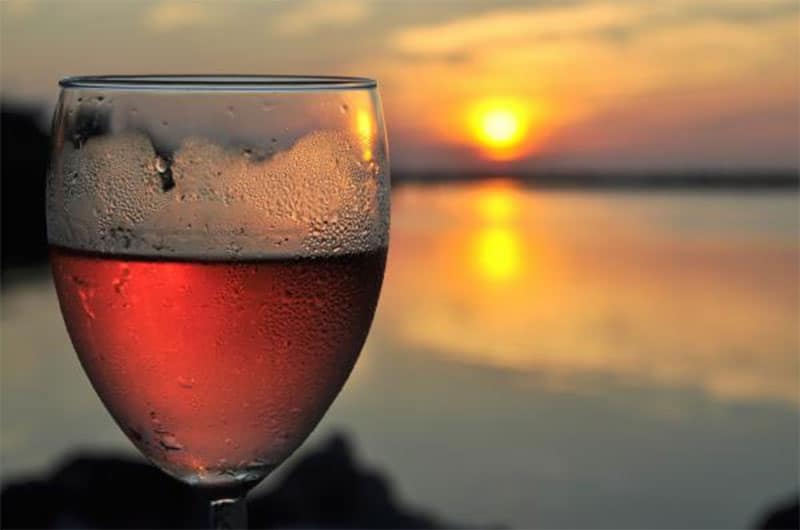– by Jenny Benzie – Advanced Sommelier + Certified Wine Educator, Proprietress of Epernay Wine & Spirits –
As you stroll along the streets of Nantucket this time of year, you would be hard pressed not to find someone wearing a pair of the famed “Nantucket Reds” long pants made of a durable canvas. Made famous here on island by the good people at Murray’s Toggery Shop on Main Street, there are several theories as to how these perfectly and aptly names trousers received their namesake. Nantucket Reds, whose unique qualities make them what they are, are often imitated, but never exactly duplicated.
The same can be considered for the plethora of rosé wines that are coincidentally similar in color to the famed pants as a symbol of the season on the island. Look at almost any wine list here and you are bound to find not only find a pink wine by the glass, but also a handful of bottle selections at varying price points from different regions as well.
The benchmark for dry rosés originates from the Provence region located in Southern France. This region has been focusing on rosé wine production for centuries. What makes this area stand out as the gold star standard is partly due to their heritage of winemaking, their ideal location on the Mediterranean coast, and also their unwavering production standards. Provence is home to some of France’s oldest vineyards and is the world’s largest wine region specializing in dry rosé. Therefore, a culture has been created around this wine and long-established traditions have maintained the quality of the product produced.
The Provence region is highly influenced by its unique sense of place that is full of sunshine, influenced by the wind off the coast and the hillsides covered with herbs. It is a perfect example of the French concept of ‘terroir’ where the wine is greatly influenced by several components of the area that have a much greater influence as a whole. The wine quality is reinforced by the Appellation d’Origine Protégée (AOP), a European system that categorizes wines by their place of origin and sets strict quality standards that are the highest for wines of each appellation. These factors combined allow the consumer to be confident that a rosé wine from Provence will designate consistent quality.
Within the Provence region, there are three major Provençal appellations that offer a stylistic uniqueness based on their microclimates. Côtes de Provence is the largest and most well-known, followed by Coteaux d’Aix-en-Provence on the western side of the region, and the least known Coteaux Varois en Provence located more inland.
You are probably wondering just how does a winemaker make rosé wine from Provence, or anywhere in the world for that matter? Red grape varietals that are traditionally grown in the region are harvested and then pressed off their skins. This allows for minimal color extraction of the skins and juice in contact together. The wine is fermented into single batch lots. Once the wine has completed fermentation, the lots are then blended in a process called “assemblage” in order for the winemaker to create the final product. This is commonly a consistent style house-blend wine that, while it reflects the soil, climate and grape varieties that it comes from, is consistent from year to year production.
The main grape variety used in this region is Grenache, also known as Garnacha in Spain. This is a thin-skinned varietal that offers little color to the wine, but results in a spicy, red berry flavor that is relatively high in alcohol. Cinsault grows well in the sunny area as it is heat tolerant and will add softeness and a fresh bouquet quality. Syrah, also known as Shiraz, is considered a thick skinned, blackish-blue hued grape that produces a more intense color concentration and fuller bodied wine on the palate. Mourvèdre grows well in the heat and thrives being near the ocean. It offers smooth, yet structured tannins and spicy characteristics. Tibouren may be the one grape you are not familiar with as it is the one grape variety that is seldom seen outside of its homeland. Highly aromatic, this is what offers the wines of Provence an earthy component. While this grape is greatly valued by producers, it is the least planted in the region due to its susceptibility to vineyard diseases. Rounding out the list of approved grape varietals is the structured carignan, which is a great base for blending, and the least commonly used but probably most well known cabernet Sauvignon.
Just like warm summers on Nantucket, Provence is known for its open skies, brisk winds, and plentiful sunshine. The climate is especially welcoming in the early fall months of September and October. The outdoor lifestyle of sunbathing, walking outside, and participating in water sports is also similar between the two regions. People tend to enjoy outdoor activities that revolve around the beautiful surroundings of the area, the fresh cuisine of bounty from the local farms and surrounding waters, and a glass of crisp, dry, refreshing wine that makes the trifecta complete.
Many would like to say that rosé wines are coming back in style, but they have never been out of style. They are part of a lifestyle that is reminiscent of what we experience here on Nantucket and also in Provence.
The slogan for Nantucket Reds, “Guaranteed to fade” (as in the color), is just like a picturesque Nantucket sunset. It is no wonder we enjoy the wines of Provence so much here on Nantucket. Cheers to that!

